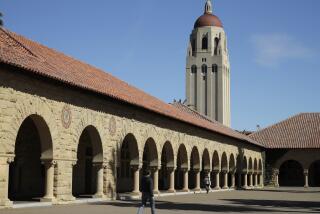Column: The rich get richer: Should the wealthy get a tax break for endowing elite universities?

Big donor, and your partner in charity? Nike co-founder and Stanford benefactor Phil Knight.
Stanford University on Wednesday announced the largest donation in its history: a $400-million gift from Nike founder Phil Knight to endow a graduate program modeled after the Rhodes Scholarships.
As a U.S. taxpayer, are you suffused with personal pride about this? Perhaps you should be, because you’re paying for much of it. Assuming that the billionaire Knight, an alumnus of Stanford’s business school, is charged the top marginal federal tax rate on his income, the donation will give him a $158-million tax break.
That’s your share.
What justifies the high per-student government subsidies at the elite private universities, and the low per-student subsidies in public universities? There is no justification.
— Former Labor Secretary Robert Reich, UC Berkeley
Knight’s gift and its tax consequences should reignite a dormant debate over how much the endowments of America’s richest universities cost taxpayers. Tax deductions for donations are only one type of hidden public subsidy that nonprofit universities collect; their investment gains also are untaxed, as is their real estate.
These benefits arguably contribute to America’s rising crisis in income and wealth inequality. Elite universities chiefly educate the children of the wealthy and upper middle class; institutions that educate working-class kids are starved of resources by comparison.
A data survey by Nexus Research last year put the mismatch in stark terms by comparing the implicit per-student subsidy at rich private institutions with the government funding of public colleges in their state. In California, it showed that Stanford received about $63,000 per student, while UC Berkeley got $10,500, Cal State Fullerton got $4,000 and Fullerton Community College $8,100.
The figures reflected estimated exemptions from capital gains taxes for the private schools and government appropriations for the others; in the interest of full disclosure, Nexus is partly funded by the University of Phoenix, a for-profit university that competes with the others.
While one may quibble with the numbers, there’s hardly any question that the difference in government contribution per student is enormous.
“What justifies the high per-student government subsidies at the elite private universities, and the low per-student subsidies in public universities?” former Labor Secretary Robert Reich, a professor at Berkeley, has asked. “There is no justification.”
The torrent of tax-deductible donations tends to flow toward a tiny cadre of extremely well-heeled institutions. Last year, according to statistics from the Council for Aid to Education, nearly one-fifth of the record $40.3 billion raised by U.S. colleges and universities went to just 10 schools. Stanford led the list with $1.43 billion.
Alumni and other individuals were the largest source of gifts, accounting for nearly 47% of the total. Through the tax deductions these donors claimed, taxpayers covered roughly $7.5 billion of the total donations.
University officials typically say that this money is crucial for enabling their institutions to do good works, such as educating needy students. That’s a dubious argument; the truth is that the richest universities have relatively small enrollments of low-income students.
One useful metric is the percentage of enrollees receiving federal Pell grants, which are available only to students from poor families. (The grants are worth $5,815 in the current academic year). At UC Riverside, 53% of all students received Pell grants in 2014; at Stanford, the figure was 17% and at Harvard, 11%.
Many donations are specifically designated for purposes other than serving the needy, and often involve more than a little vanity. In 2002, Meg Whitman, then riding high as CEO of eBay and today the CEO of Hewlett Packard, made a $30-million donation to Princeton University, her alma mater, to build a lavish new dorm to be named Whitman College. Taxpayers covered an estimated $10 million of the total. Prior to his $400-million gift to Stanford, Phil Knight made a $105-million donation in 2006, almost all of which went into a new classroom building for the business school, dutifully named the Knight Management Center.
It may be true that many large donors are motivated by genuinely philanthropic impulses, but tax planning undoubtedly plays a large role in gift-giving. Philanthropies give the game away by forecasting losses of 20% to 25% of their donations whenever Congress ponders a cutback of tax breaks for charitable giving.
Universities are among the loudest opponents of such initiatives; they helped kill a 2008 effort in the Massachusetts legislature to impose a 2.5% tax on university endowments over $1 billion. “If donors knew that the money they bequeathed to their alma mater would partially or fully be heading to the state... they would think twice before writing that check,” editorialized the student-run Harvard Crimson (perhaps looking ahead to its staffers’ future tax planning). Harvard’s endowment last year reached $36.5 billion.
The truth is that universities with multibillion-dollar endowments are engaging in business every bit as much as multibillion-dollar corporations. They’re the equivalent of real-estate magnates and hedge fund investors with the heft to move the markets in any sector they choose -- even more so, since their tax exemptions allow them to take bigger risks than taxpaying funds or individuals.
Nothing about the U.S. tax code’s deductions for charitable giving or exemptions for charities’ investments steers these activities to works that do the most public good -- or any public good -- which is the putative rationale for the breaks. A donation to a scholarship program for the poor or an inner-city health clinic is worth exactly as much to the donor as building a luxurious new dorm so his or her kids can have all the comforts of home while they’re studying or sowing their wild oats. And it costs the taxpayers as much, too.
“Schools, including Princeton, are spending vast amounts becoming mini-luxury resorts, with fancy housing, spectacular recreational facilities and the like,” observed Ohio University economist Richard K. Vedder in 2013. “At the minimum, these commercial activities should be taxed.”
Knight’s huge donation to the nation’s fifth-richest university (Stanford endowment in 2015: $22.2 billion) should prompt a reexamination of the tax rules for elite universities. Congress could follow the abortive lead of Massachusetts by pegging tax breaks to the size of a recipient institution’s endowment and eliminating them altogether for the richest. Or it could set specific spending goals -- mandating that a certain percentage of spending goes to low-income scholarships or to support graduates working in needy communities, say. Certain directed gifts should lose their tax deductions entirely, such as those for income-producing dorms or other construction.
If alumni really don’t want their donations going to “the state,” as the privileged characters at the Harvard Crimson groused, why not sequester the take from university-related taxes in a special fund devoted to educational opportunities for the poor, or to shore up a state’s support of its public universities?
The possibilities are endless. Before we hail Phil Knight for his charitable instincts, let’s think about how his $400-million gift ($242 million, net of his tax break) could be put to better use.
Keep up to date with Michael Hiltzik. Follow @hiltzikm on Twitter, see our Facebook page, or email michael.hiltzik@latimes.com.






